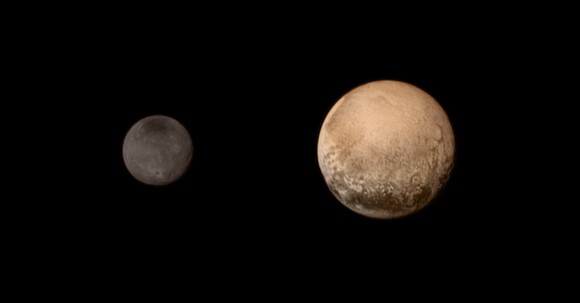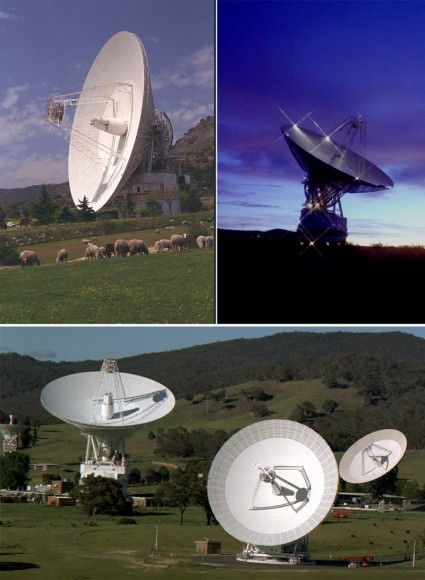If you thought the New Horizons spacecraft flyby of the Pluto system happened waaaay too fast and you’re pining for more images and data, you are in luck. What the spacecraft has been able to send back so far is just the tip of the icy dwarf planet, so to speak.
Starting tomorrow, Saturday, September 5, 2015, the spacecraft will begin an “intensive” downlink session that will last for a year or more, sending back the tens of gigabits of data the spacecraft collected and stored on its digital recorders during the flyby. What will come first are “selected high priority” data-sets that the science team has been anxiously waiting for.
“This is what we came for – these images, spectra and other data types that are going to help us understand the origin and the evolution of the Pluto system for the first time,” said New Horizons Principal Investigator Alan Stern. “And what’s coming is not just the remaining 95 percent of the data that’s still aboard the spacecraft – it’s the best datasets, the highest-resolution images and spectra, the most important atmospheric datasets, and more. It’s a treasure trove.”
Can I get a fist pump, all you Plutophiles?
#ThrowbackThursday. Remember our "1st-look" #PlutoFlyby photos? In Sep, we'll get "Selected High Priority" data-sets pic.twitter.com/YVj7F2U5mP
— NASA New Horizons (@NASANewHorizons) August 27, 2015
Plus, every Friday from here on out, you can count on getting new, unprocessed pictures from the Long Range Reconnaissance Imager (LORRI) on the New Horizons project website. Here’s where you can find the images, and the next LORRI set is scheduled for posting on Sept. 11, so set your calendars.
It’s been 7 weeks since New Horions’ historic flyby of the Pluto system, and during this quick pass, the spacecraft was designed “to gather as much information as it could, as quickly as it could, as it sped past Pluto and its family of moons – then store its wealth of data to its digital recorders for later transmission to Earth,” said the mission team.

Why is it taking so long? The spacecraft runs on between 2-10 watts of power, and it had to prioritize on data collection during the flyby. The data has been stored on two onboard, solid-state, 8 gigabyte memory banks. The spacecraft’s main processor compresses, reformats, sorts and stored the data on a recorder, similar to a flash memory card for a digital camera.
One issue is the time it takes to get data from New Horizons as it speeds even farther away from Earth, past the Pluto system. Even moving at light speed, the radio signals from New Horizons containing data need more than 4 ½ hours to cover the 4 billion km (3 billion miles) to reach Earth.
But the biggest issue is the relatively low “downlink” rate at which data can be transmitted to Earth, especially when you compare it to rates now common for high-speed Internet surfers.

During the Jupiter flyby in February 2007, New Horizons data return rate was about 38 kilobits per second (kbps), which is slightly slower than the transmission speed for most computer modems. Now, after the flyby, the average downlink rate is going to be approximately 1-4 kilobits per second, depending on how the data is sent and which Deep Space Network antenna is receiving it. Sometimes, when possible, the spacecraft will be able to increase the rate by downlinking with both of its transmitters through NASA’s largest antennas of the DSN. But even then, it will take until late 2016 to send Pluto flyby data stored on the spacecraft’s recorders.
Patience you must have, my young padawan.
“The New Horizons mission has required patience for many years, but from the small amount of data we saw around the Pluto flyby, we know the results to come will be well worth the wait,” said Hal Weaver, New Horizons project scientist.
The data received by the DSN (you can watch the live data link happen on the Eyes of the Solar System DSN NOW page) will be sent to the New Horizons Mission Operations Center at the Applied Physics Lab a Johns Hopkins University, where data will be “unpacked” and stored. Then mission operations and instrument teams will scour the engineering data for performance trend information, while science data will be copied to the Science Operations Center at the Southwest Research Institute in Boulder, Colorado.
At the Science Ops Center, data will pass through “pipeline” software that converts the data from instrumental units to scientific units, based on calibration data obtained for each instrument. Both the raw and calibrated data files will be formatted for New Horizons science team members to analyze. Both the raw and calibrated data, along with various ancillary files (such as documents describing the pipeline process or the science instruments) will be archived at the Small Bodies Node of NASA’s Planetary Data System.
More info: New Horizons


It’s hard to find much speculation on the core temperature of Pluto. Just wondering what could be driving all that resurfacing. Really, all the pointless Pluto drama aside, what a triumphant set of images so far. Haumea, I hope you’re next.
I wish that there was some kind of Moore’s law concerning spacecraft. We need less cost, more delta v and less mass, then we can hang out at KBO’s once we get there. I guess that’s the Mars problem too though. We’re not even close to being able to orbit a distant dwarf planet.
If the tests of the EM and Cannae drives at Nasa’s Eagleworks Labs continue to prove-out defying and re-writing the laws of physics, you may get your wish..
What do we know about the protocol for sending the data back? The large distance probably means the data rate has to be slowed down because the power received here at earth is lower (than when the probe was at Jupiter). If the data is just streaming off the probe then the 4 1/2 hour delay to get here is only a delay and not a hindrance to speed. But if there is handshaking between the probe and us then there would be a 9 hour delay to make and notice any changes to the data stream. Is there any error detection and correction. Do we let the probe know when we have received any set of data. Does the probe delete the data after we acknowledge receiving it to make room for more?
It is almost ubiquitous in satellite/spacecraft communications to use a technique known as Forward Error Correction (FEC), where the transmitting source duplicates the data bits it is about to send, creating two identical streams of ones & zeros. Then it offsets the two identical streams by a certain preset number of data bits and “adds” them together to produce a single line of symbols. Where like bits line up in the overlap, they produce a zero; where unlike bits line up, a one is produced. Once the new symbol stream is calculated (effectively a real-time process) the resulting stream of symbol bits is then transmitted. Since the receiver knows exactly how far the two data streams were offset to produce the symbol stream it’s getting — sometimes the transmitter will signal that information at the outset while the receiver adapts accordingly, sometimes it’s pre-programmed, etc. — it’s simple for the receiver to decipher the original stream from the resulting set.
The key attribute of this process is that even if the receiving station loses a few bits here & there thanks to low power levels or background noise, each data bit is effectively sent out twice for the price of a single stream, making the data considerably more robust than it would otherwise be.
At the very long distances (read: low receive levels) New Horizons is having to bridge, it is also likely that each symbol bit is being sent repeatedly over some longer-than-usual span of time, say at a 16:1 ratio, where 16 time-slots in a row will stand for a single symbol bit. Any bits received during those 16 slots will all count toward the same symbol — even if only one slot is decipherable by the receiver — and if more than one type of bit is received the receiver will know that the data is inherently corrupt and subsequently re-initiate communications. Naturally, this slows things down quite a lot, but it further ensures that each bit of data has the greatest chance of being received despite the low power of the transmission compared to the static-y background of deep space.
Please note that I speak only in general SatCom terms here; I have no in-depth knowledge of New Horizons’ communication set-up or programming specifically. However, it would not be at all surprising if the methods above, among others, were used to maximize signal clarity at the expense of speeds we’d otherwise expect in the broadband era.
“I have no in-depth knowledge of New Horizons’ communication set-up”
Sounds like a story idea for Nancy. 🙂
Agreed!
Let the science buffet begin.. Just wow!!!
I hope New Horizons will survive until he sent all data available
Smokey, thank you for the explanation of Forward Error Correction. This is an area where those of us who have been out of school for too long need help from sharp guys like you.
(I’m so old I need a refresher in modem technology!)
Lol, no worries, Pete! I’m not so young as I once was either, but I have the advantage of working with the hardware on something of a daily basis, so some of the principles were bound to rub off. ^_~
There are many different ways FEC is implemented, and the one I described is only one of them, but the principle behind all of them is the same: provide clues to any given bit via multiple other bits in the stream so that the actual data is that much less likely to be “lost in transmission.”